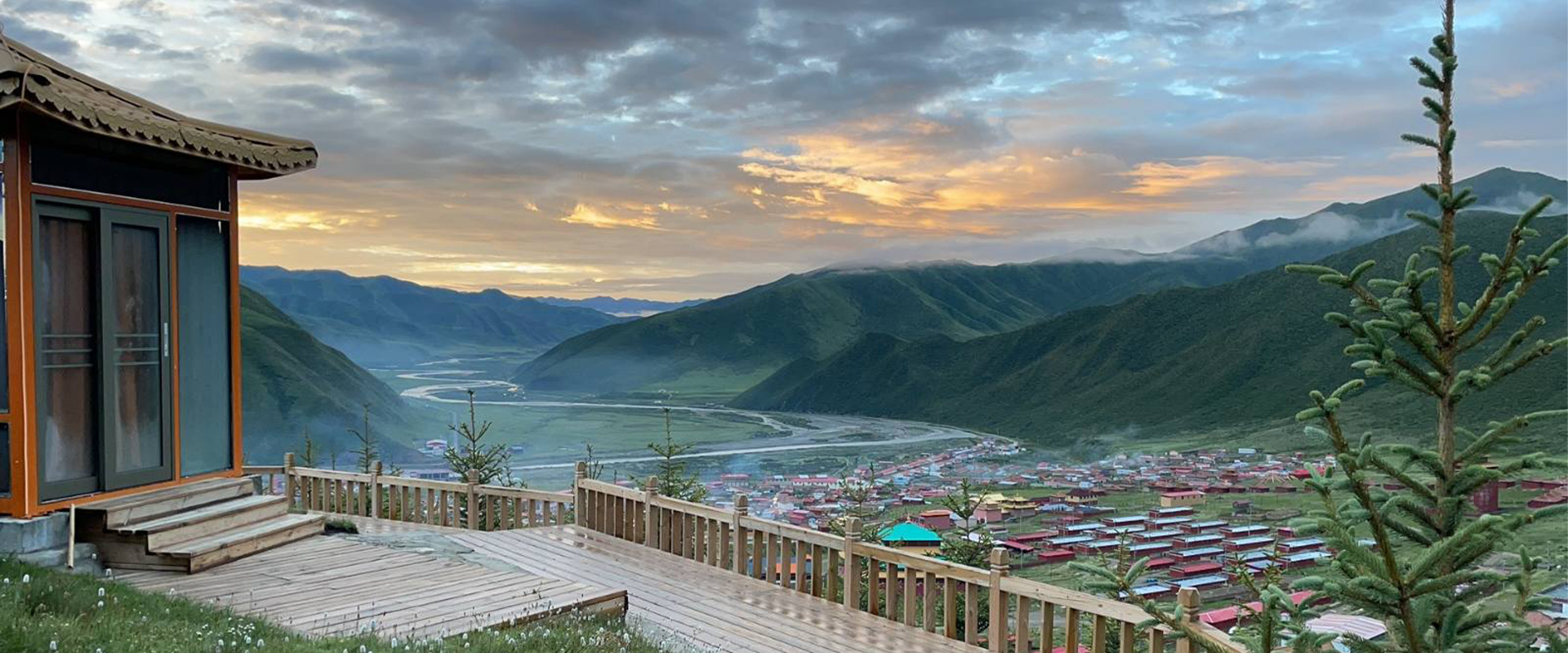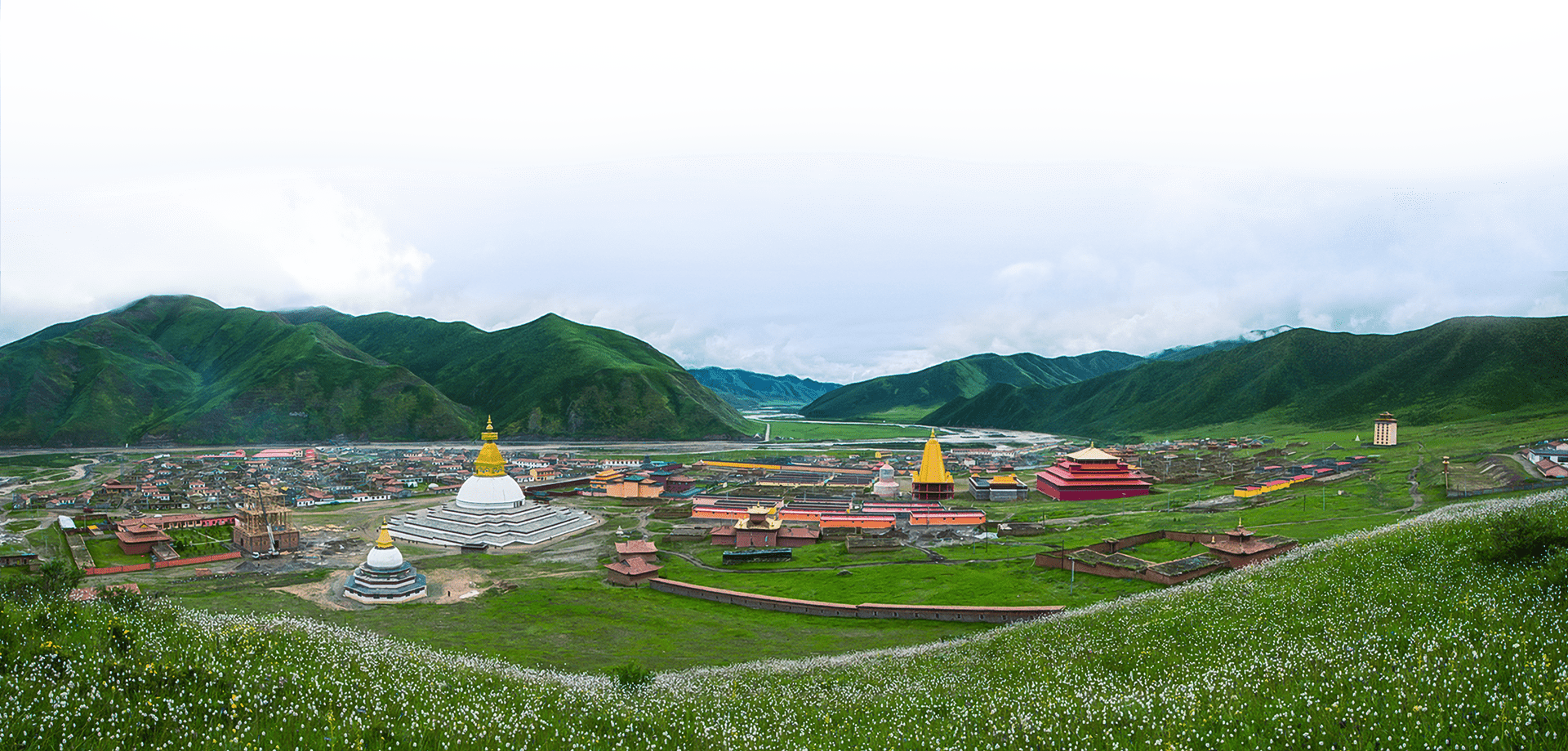Vimalamitra

VIMALAMITRA (Dri Med bShes gNyen) was born at the Forest of Elephants (Glang Po’i Tshal) in western India. His father was Deden Khorlo, and his mother was Dak-nyid Salma. He became a scholar of both Hīnayāna and Mahāyāna.
He was one of the five hundred scholars who were residing at Bodhgayā. One day, to ease the heat, Vimalamitra and Jñānasūtra walked about two miles to the west of Bodhgayā to a marsh where many sweet-scented flowers were blooming. From the sky Vajrasattva appeared and said to them, “O sons of good family, you have each taken birth five hundred times as scholars, yet till now you have never achieved the supreme result, nor will you do so in the future. If you would like to attain the enlightenment of the disappearance of the defiled body in this very life, go to the temple near the Bodhi Tree in China.”
Vimalamitra was full of diligence. Immediately he took up his begging bowl, which was the only possession he had, and set out for China. He met Shrīsiṃha at the temple near the Bodhi Tree and received the oral transmission of Nyingthig of Me-gagde and the teachings of Outer, Inner, and Esoteric cycles for twenty years. But Shrīsiṃha did not give him their texts. Fully satisfied, Vimalamitra returned to India and recounted his achievements to Jñānasūtra. Jñānasūtra went to China and received the teaching of all the four cycles of Nyingthig from Shrīsiṃha. In addition he was given the texts themselves. Shrīsiṃha also left him his testament when he attained the rainbow body. Then Jñānasūtra returned to India and lived at Bhasing charnel ground, giving discourses to ḍākinīs.
Vimalamitra was practicing esoteric exercises in the charnel ground of Thachung. One day he was wandering through the charnel ground riding on a blue elephant, with his upper robe over his right shoulder and holding a parasol over his head, and the Ḍākinī Palkyi Lodrö appeared in the sky and gave this prophecy: “O fortunate one, if you would like to receive deeper instructions of Nyingthig than before, go to the forest of Bhasing charnel ground.” He went at once, and there he met Jñānasūtra, whom he beseeched to give him the deep teachings. In order to show his power of realization, Jñānasūtra emitted a beam of light from his urna (a circle of hair on the forehead) and by a mere glance filled the sky with the display of the Samghogakāya pure land. Vimalamitra developed unshakable faith in him. Immediately Jñānasūtra conferred on him the elaborate empowerment, and the urna of Vimalamitra was opened. He also entrusted Vimalamitra with the texts and instructions of the first three cycles of Nyingthig. One year later at a temple, Jñānasūtra conferred the simple empowerment, and steam emerged from every pore of Vimalamitra’s body. He was given the text of the Innermost Esoteric cycle of Nyingthig. After practicing the preparatory exercises on the experiences of saṃsāra and nirvāṇa for six months at the peak of Mount Söche, Vimalamitra received the very simple empowerment, followed by instructions. He achieved uncommon experiences and realizations, and on the tip of his nose there appeared a white letter ĀḤ, which seemed on the verge of falling. Six months later Vimalamitra was given the complete utmost simple empowerment, and he realized the naked nature of the mind. He was also given the complete instructions on the essential points of Nyingthig. Then Vimalamitra stayed with his teacher for fourteen years, perfecting his realization of Nyingthig.
Then Jñānasūtra entered nirvāṇa without bodily remainder. When Vimalamitra prayed with devotion the forearm of the master from the midst of a mass of radiant light in the sky emerged and placed in Vimalamitra’s palm a casket studded with five kinds of precious jewels. From it he discovered the testament The Four Methods of Contemplation, and instantly he achieved a realization equal to that of his master.
Then, living in a bamboo hut, Vimalamitra spent twenty years as the preceptor of King Haribhadra (Excellent Lion) in the city of Kāmarūpa in eastern India. Then he went to the city of Bhirya in western India and accepted the devotion and services of King Dharmapāla.
Then for seven years, with numerous hosts of ḍākinīs, he practiced Nyingthig in Prabhāskara, a great mysterious charnel ground not very far from Bhirya city. Pursuing esoteric exercises through various forms and methods, he gave teachings to an inconceivable number of disciples. He attained the vision of the perfection of intrinsic awareness (Rig Pa Tshad Phebs), the third of the four stages of high Dzogpa Chenpo, and then achieved the light body of great transformation (’Pho Ba Ch’en Po) and led three thousand people into enlightenment. Then, for thirteen years, he stayed in the same charnel ground in various manifestations.
In this charnel ground he made three copies of the sacred texts of Nyingthig. He concealed one copy in the island covered by golden sand in the ocean of Oḍḍiyāṇa in western India. He concealed another copy in a cave in Suvarṇadvīpa in Kashmir, and the final copy he preserved in Prabhāskara charnel ground as the object of devotion for the ḍākinīs.
Vimalamitra also saw Prahevajra seven times in pure visions and received instructions directly.
At that time, King Trisong Detsen of Tibet had just established the Buddha Dharma in Tibet. A great Tibetan master named Tingdzin Zangpo of the Nyang family gave the king the prophetic advice that he should invite the great esoteric master Vimalamitra from India. Tingdzin Zangpo was able to sustain a period of contemplation for seven years and could see the four continents by the power of his flesh eye, the power of supernormal vision that perceives physical phenomena. Accordingly, King Trisong Detsen sent the translators Kawa Paltsek and Chok-ro Lü’i Gyaltsen to India with presents of gold and a message to the young King Indrabhūti of Serkya city, saying, “Please send a great tantric master from among your five hundred scholar preceptors.” Vimalamitra had then attained the body of great transformation (’Pho Ba Ch’en Po) and was staying as one of the five hundred preceptors of the king. King Indrabhūti and his scholars agreed on the choice of Vimalamitra as the one to be sent to Tibet. Realizing that it was the appropriate time to go to Tibet, Vimalamitra accepted the invitation.
Vimalamitra went to Tibet with master Kṣhitigarbha as his attendant, taking along one copy of the sacred texts of Nyingthig. At the time of his departure many people in India had bad dreams, sinister astrological omens occurred, flower and fruit-bearing trees bent to face in the direction of Tibet, and signs appeared indicating the jealousy of the ḍākinīs of the charnel ground. Because of the omens, the Indians realized that the secret teachings had slipped through their fingers, and they sent swift-footed messengers to create doubts in the minds of the Tibetans. The messengers placed posters at the junctures of valleys and the crossroads of cities saying, “Two Tibetan monks have carried off an Indian black magician who is going to destroy Tibet.” So when Vimalamitra reached Samye, the Tibetans were in a state of doubt about him. When he paid homage to an image of the Buddha Vairochana, it disintegrated to dust before him. When he blessed the heap of dust, the image restored itself, more magnificent than before. Faith in Vimalamitra slowly developed in the Tibetans, and he was able to give them teachings.
One day, while he was giving sūtric teachings to an assembly of disciples, he returned to the hall after a recess period and found a note on his seat. It said:
Buddhahood cannot be attained by the babyish Dharma of the shrāvakas;
the distance cannot be covered by the raven’s vajra steps.
Inquiries were made, and the author of the note was discovered. Asked who he was, he replied, “I am Yudra Nyingpo, a disciple of Pakor Vairochana,” the great translator. At that time Vairochana was in exile in Gyalmo Rong, in Eastern Tibet. Vimalamitra and Yudra Nyingpo compared their teachings and realizations and found them to be equal.
Thereafter for ten years, Vimalamitra worked together with a team of translators. With Yudra Nyingpo, he translated the thirteen “later translated texts” of Semde, as Vairochana had already translated the five “earlier translated texts” of the eighteen Semde texts. With Nyak Jñānakumāra, he translated the Guhyagarbha-māyājāla-tantm, among other texts of Mahāyoga, and some instructional texts of Semde and Longde. He translated the root texts and instructional texts of the Outer, Inner, and Esoteric cycles of Me-ngagde with Nyak Jñānakumāra. The teachings of the Innermost Esoteric cycle, the Nyingthig of Me-ngagde, were kept confidential among the master, the king, and Nyang and were translated in strictest secrecy. The Nyingthig teachings that were brought to Tibet by Vimalamitra are known as Vima Nyingthig.
Vimalamitra could find no other disciple to whom it would be appropriate to entrust the texts of the Innermost Esoteric cycle (the four volumes, etc., on Nyingthig). He concealed the Tibetan translations at Trakmar Gekong in Chimphu near Samye Monastery.
After staying in Tibet for thirteen years, Vimalamitra departed for the Five Peaks in China. Because he has attained the rainbow body of great transformation, in fulfillment of his aspiration he shall remain there as long as the Buddha Dharma exists. He has promised to send an incarnation of himself to Tibet every century, to carry out the work of maintaining and disseminating the Nyingthig teachings for as long as the Buddha Dharma exists. When Buddhism ceases to exist, Vimalamitra will dissolve into the ultimate sphere at Bodhgayā.
Believers think that if your spiritual eyes are clear, you can see him in person at the Five Peaks. There are many incidents of seeing and receiving teachings from Vimalamitra at the Five Peaks. I heard many stories from my teacher Kyala Khenpo Rinpoche when I was young. Here is one that I can recall: An important Lama (whose name I have forgotten) went to the Five Peaks on pilgrimage with his disciples. One day when they were going in circumbulation, they saw a Chinese shoemaker sitting under a rock by a footpath. The Lama with respect sat before the shoemaker. The shoemaker without any hesitation put the shoes he was making on the head of the Lama and had him drink the filthy water he kept by his side. All the Lama’s disciples were shocked and ashamed, for many pilgrims were watching and laughing at the Lama. Later, the disciples learned from the Lama that the shoemaker was in fact Vimalamitra, and he had been receiving empowerments. The disciples rushed back to the rock but could find no trace that anybody had ever stayed there. Unless you are an accomplished person, the best you can see of Vimalamitra is as a bird, a rainbow light, or an ordinary person and the like.
Fifty-five years after Vimalamitra’s departure for the Five Peaks, Nyang built the Zha Temple in Drikung Valley of Uru Province. In that temple he concealed the texts of the expository tantras of the first three cycles as well as the texts that belong to the oral transmission and some Innermost texts. The words of the oral transmission were transmitted to Dro Rinchen Bar. Finally, Nyak dissolved his mortal body into the rainbow body.
Dro Rinchen Bar transmitted the oral transmissions to Be Lodrö Wangchuk, who in turn transmitted them to Neten Dangma Lhüngyal (11th century). Neten also discovered the texts concealed by Nyang and entrusted the transmission to Chetsün Senge Wangchuk (11th– 12th centuries). Chetsün also discovered the Nyingthig texts along with Vimalamitra’s testament, concealed at Gekong at Chimphu by Vimalamitra and transmitted to Zhangtön Tashi Doge (1097–1167).
The name of the lineage teachers of Vima Nyingthig from the Dharmakāya down to the present masters are as given earlier.
Tulku Thondup
“Masters of Meditation and Miracles: Lives of the Great Buddhist Masters of India and Tibet”









